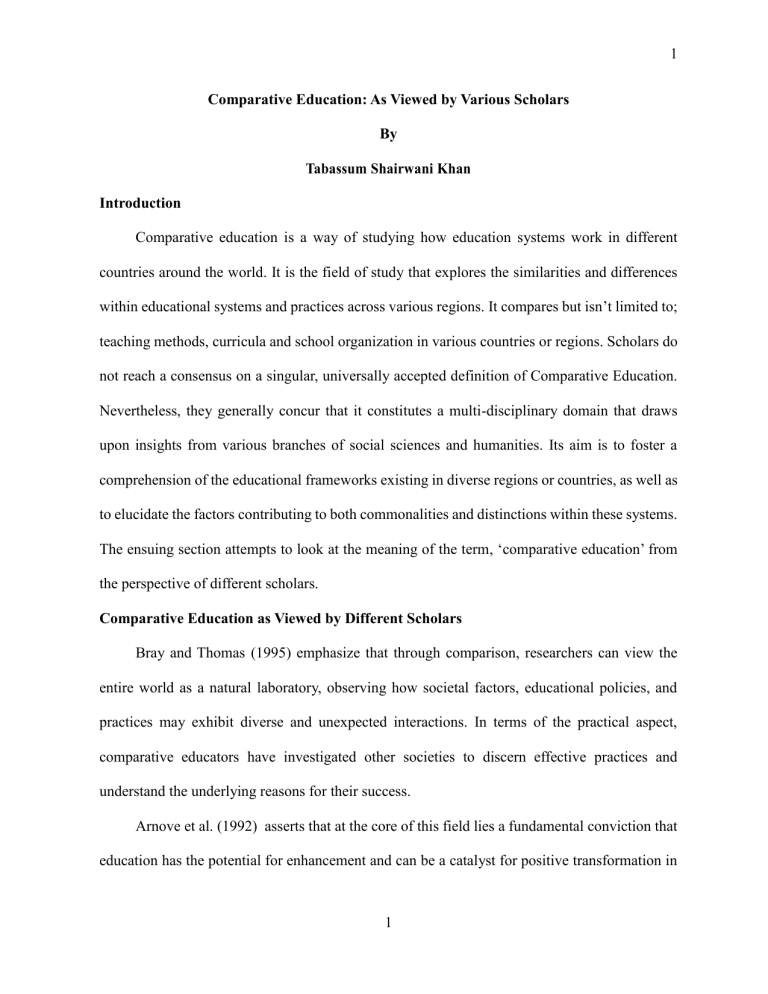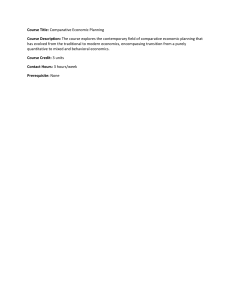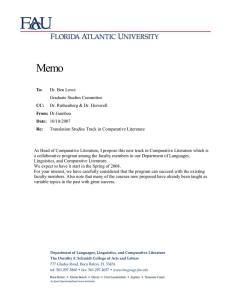Comparative Education: Scholars' Views & Global Perspectives
advertisement

1 Comparative Education: As Viewed by Various Scholars By Tabassum Shairwani Khan Introduction Comparative education is a way of studying how education systems work in different countries around the world. It is the field of study that explores the similarities and differences within educational systems and practices across various regions. It compares but isn’t limited to; teaching methods, curricula and school organization in various countries or regions. Scholars do not reach a consensus on a singular, universally accepted definition of Comparative Education. Nevertheless, they generally concur that it constitutes a multi-disciplinary domain that draws upon insights from various branches of social sciences and humanities. Its aim is to foster a comprehension of the educational frameworks existing in diverse regions or countries, as well as to elucidate the factors contributing to both commonalities and distinctions within these systems. The ensuing section attempts to look at the meaning of the term, ‘comparative education’ from the perspective of different scholars. Comparative Education as Viewed by Different Scholars Bray and Thomas (1995) emphasize that through comparison, researchers can view the entire world as a natural laboratory, observing how societal factors, educational policies, and practices may exhibit diverse and unexpected interactions. In terms of the practical aspect, comparative educators have investigated other societies to discern effective practices and understand the underlying reasons for their success. Arnove et al. (1992) asserts that at the core of this field lies a fundamental conviction that education has the potential for enhancement and can be a catalyst for positive transformation in 1 2 all nations. The authors additionally observe that comparative research has frequently aimed to uncover how alterations in educational delivery, structure, and substance could play a role in poverty reduction or dismantling disparities based on gender, class, and ethnicity. This belief in the influential capacity of education systems aligns with three primary dimensions of the field. The classification from Arnove (2013) categorizes the field of Comparative Education into three key dimensions, each of which serves a distinct purpose: 1. Scientific/Theoretical Dimension: This dimension emphasizes the scholarly and theoretical aspects of Comparative Education. Scholars within this dimension focus on the rigorous examination and analysis of educational systems from a theoretical standpoint. They seek to develop a deeper understanding of the underlying principles, concepts, and theories that govern education in different regions or countries. This dimension is concerned with advancing knowledge about education as an academic discipline and often contributes to the development of educational theories and paradigms. 2. Pragmatic/Improvement-Oriented Dimension: In this dimension, the primary focus is on the practical application of comparative research to enhance education systems. Researchers and practitioners in this dimension are concerned with identifying tangible ways to improve educational provision, curriculum, and educational outcomes. They may investigate policies, strategies, and practices that can lead to positive changes in education, such as reducing poverty, promoting equity, and addressing social inequalities. 3. Global/International Comprehension and Harmony Dimension: This dimension is oriented towards fostering a broader perspective on education by examining its global and international dimensions. Scholars and practitioners in this dimension explore how education can contribute to global understanding, peace, and cooperation among nations. They may study issues related 2 3 to international education, cross-cultural communication, and the role of education in promoting cultural exchange and diplomacy on a global scale. Arnove's classification recognizes that Comparative Education encompasses not only the theoretical and practical dimensions but also acknowledges the field's potential to contribute to global harmony and cooperation through education. These dimensions collectively provide a comprehensive framework for approaching the study and practice of education in a comparative context. As articulated by Giddens (1990) and Rizvi and Lingard (2009) the significance of international comprehension has gained paramount importance within the sphere of comparative education. This is particularly evident as the accelerating processes of globalization compel individuals to acknowledge how socioeconomic influences, originating from regions once perceived as distant and detached, now exert a tangible impact on their day-to-day existence. It is crucial to note that the emphasis placed on these aspects not only differs from person to person, but also varies significantly across national and regional boundaries, as well as within distinct epistemic communities. This underscores the dynamic nature of international understanding and its evolving role in shaping education policies and practices on a global scale. As such, it becomes imperative for educational systems and stakeholders to adapt and respond effectively to this shifting landscape, ensuring that learners are equipped with the requisite knowledge and skills to thrive in an increasingly interconnected world. According to Wilson (2003), comparative education can be characterized as a meeting point of social sciences, education, and cross-national analysis. Its primary objective lies in leveraging cross-national data to empirically evaluate hypotheses concerning the complex relationship between education and society, as well as the dynamic relationship between teaching methodologies and learning outcomes. Wilson astutely observes the enduring lineage of 3 4 comparative and international education. Throughout recorded history, scholars and explorers have documented facets of education in the various lands they visited, driven by the belief that the educational structures and practices they encountered held valuable insights for potential adoption and adaptation within their own homelands. This enduring tradition underscores the constant search for knowledge exchange. The essential nature of comparative education is dynamic and expands with the growth of knowledge. Conclusion In light of the above discussion it can be deducted that Comparative Education is a scholarly discipline focused on scrutinizing and contrasting diverse educational systems, policies, practices, and results across different countries or regions. Its primary objective is to discern the commonalities, distinctions, merits, and drawbacks of these systems, ultimately aiming to generate valuable insights that can guide educational policymaking, reform efforts, and advancement. It encompasses several fundamental dimensions such as inter-nation and policy analysis, historical evolution of educational systems of different countries, societal and cultural settings in which education takes place, investigating learning outcomes, and policy adaptation and adoption in the field of education. Comparative education stands as an invaluable instrument for policymakers, educators, and researchers seeking a broader perspective on the strengths and weaknesses of diverse education systems. By identifying effective practices and comprehending the contextual factors that shape them, comparative education contributes to the ongoing endeavors to enhance the quality and accessibility of education on a global scale. 4 5 References Arnove, Robert F., Philip G. Altbach, and Gail P. Kelly. 1992. Introduction. In Emergent issues in education. Edited by Robert F. Arnove, Philip G. Altbach, and Gail P. Kelly, 1–10. Albany: State Univ. of New York Press. Arnove, Robert F. 2013. Introduction: Reframing comparative education; The dialectic of the global and the local. In Comparative education: The dialectic of the global and the local. 4th ed. Edited by Robert F. Arnove, Carlos Alberto Torres, and Stephen Franz, 1–26. Lanham, MD: Rowman and Littlefield. Bray, Mark, and R. Murray Thomas. 1995. Levels of comparison in educational studies: Different insights from different literatures and the value of multilevel analysis. Harvard Educational Review 65.3: 474–491. DOI: 10.17763/haer.65.3.g3228437224v4877 Giddens, A. (1990). The consequences of modernity. Choice Reviews Online, 28(03), 28–1843. https://doi.org/10.5860/choice.28-1843 Leflam Media. (n.d.). The scope of comparative education. http://camponotes.blogspot.com/2013/01/the-scope-of-comparative-education.html Rizvi, F., & Lingard, B. (2009). Globalizing education policy. In Routledge eBooks. https://doi.org/10.4324/9780203867396 Wilson, D. (2003). The future of comparative and international education in a globalised world. In Springer eBooks (pp. 15–33). https://doi.org/10.1007/978-94-007-1094-8_2 5


